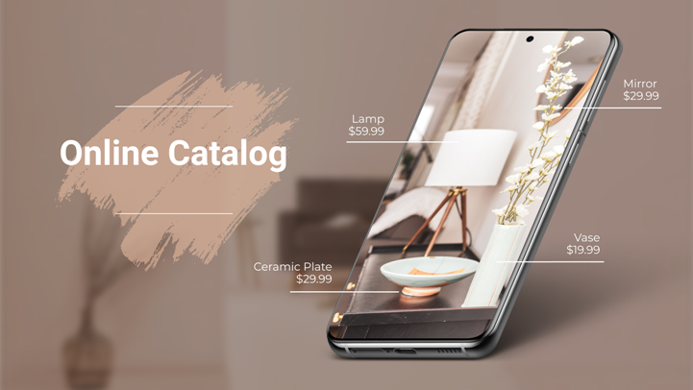Product catalogs have always been a fundamental tool for sales and marketing. No wonder, because business and sales catalogs are an amazing way to help customers make informed purchasing decisions. And digital catalogs are as relevant as they have ever been for they’re easy to share, rich with interactivity, and help you save on printing and distribution costs. Ultimately, they let companies raise their brand awareness and increase sales.
If you want to create your first online catalog or enhance an existing one, you’ve come to the right place. Today we’re going to talk on how to make a product catalog and what benefits it can bring. Let’s not waste another minute and get right to it.
#1 Define Your Audience
The first step to create an online catalog is to understand what kind of customers you’re targeting. Is it a catalog for the general public? Then make your catalog engaging and fun. Or is it meant for dealers? Then staff your catalog with precise data and characteristics.
When you specify your audience, you can start planning how your catalog will look and adjusting its style: cover, language, images, and product descriptions. This will show your customers that you care about their comfort and they will be glad to come back to you for more. Thus, you create trust and increase traffic and sales.
#2 Create an Engaging Cover
Let your catalog cover serve as a memorable first impression for the readers: make sure you design a neat and informative cover to encourage people to look inside. Check out the easy steps you can follow on how to create an online catalog with an outstanding catalog cover:
- Display your company name and logo prominently: Make them easy to read at first glance as they introduce your catalog to the customers. Remember to give two ways to contact you: list your phone number and your web address so that the readers know how to contact you from the start.
- Pick a winner for the cover photo: Choose a product that the majority of your customers would like to buy. Next to it, list the page number, further encouraging the reader to flip through the catalog to the right info/information.
- Place your special offers on the cover: Briefly mention seasonal discounts, free shipping, or limited product editions. Your readers may never get to read the whole catalog, so put your best offer right upfront.
- Keep your brand consistency: Use your company colors, fonts, and style to make it simple for your clients to recognize you and start reading right away.
Take a look at this example of a holiday product catalog made with FlippingBook that has a beautiful atmospheric cover and a clear headline.
Create yours
#3 Showcase Your Products at Their Best
Creating a digital product catalog allows you to promote your products in the most visual and attractive way. But first, think about the design and ask yourself these questions:
- Do you want to give more weight to your images or to your product information?
- Should you do a product photoshoot with a professional or you can do it in-house?
- How many images will be shown for each product?
- Will you be including more visual resources like pop-up images or videos?
If your goal is to provide customers with all available information about your products, a traditional catalog design would be recommended. But if you create a holiday catalog or want to generate curiosity and ensure your catalog makes a strong impression on the user, you can add more visual elements and interactivity.

Nowadays, many tools offer product catalog templates making your design process much easier. For example, FlippingBook specially created a template in Canva—it has a convenient square format giving you more space for the product descriptions and photos. Just check it out.
💡 If you want to create a catalog but don't have a PDF yet, we've got you covered. Check out these free catalog Canva templates that you can design and then get back to FlippingBook for creating digital catalogs right away. What's more, FlippingBook has a convenient integration with Canva that allows you to seamlessly proceed from designing a PDF in Canva to publishing your PDF to FlippingBook, where you can customize it and make it fun and interactive.
#4 Launch and Promote
Hurrah! You’ve created your product catalog. Now it’s time to let the world know about it. You may have already decided how to promote and share it to achieve your sales goals, so we’ll just cover the main methods here:
- Launch a special email campaign to share the catalog with your customers.
- Create a landing page on your website to advertise your new catalog. Don’t forget to feature a CTA or a link to your new landing page on a resource page or even your homepage.
- Leverage paid advertising and co-marketing partnerships that will help you promote your catalog to a new audience.
- Announce your new catalog launch on social media and insert a link to it in your posts.
- Write relevant and clear title and description for your catalog to make it easy and fast for your clients to find it on Google.
6 Benefits of a Digital Product Catalog
Digital catalogs are a great way to make your marketing and sales activities more efficient. Think of your catalog as your silent salesman: it can sell your products even when you’re not there to talk them up. Check out our video on how to create powerful interactive catalogs and wow your readers right away! And then read on to learn why creating a product catalog online is perfect for increasing your sales.
#1 Fast and Easy Sharing
Sharing your online product catalog with sales reps, clients, and dealers becomes as easy as pie—just send a link to your digital marketing catalog via email, no matter the size of your catalog. You can also post your catalog on social networks, embed it into your website to reach a wider audience, or place a QR code anywhere you need. Such a tool as FlippingBook allows you to generate a QR code, download it in the PNG format, and use it on your website, blog, or printed materials. The more channels, the better!
See for yourself: scan this code to see a gorgeous catalog.
#2 Convenient Navigation and Search
How to create a product catalog that allows its readers to quickly find the info they are looking for? The best way is to add a table of contents and enable text search so that your clients easily navigate around your product catalog even if it has more than 500 pages. And your sales reps will be happy to use it as a handy reference tool.
Check out the convenient navigation in this digital catalog made with FlippingBook: your readers can go to any section of the e-catalog from any page they want.
Create yours
What's more, FlippingBook allows you to create a table of contents from scratch: just upload your PDF to FlippingBook and make a table of contents right away with the help of its handy Table of Contents Editor. Plus, the software will automatically pull up the bookmarks from your PDF file and transform them into an interactive table of contents.
#3 Rich Interactive Content
You can make the most of the digital format by enriching your content with interactive elements:
- Brand your catalogs with your logo, background image, and corporate colors to create a consistent image for your sales materials. If you don’t have a logo yet, use a logo maker to design one that uniquely reflects your brand's identity. Once your branding elements are ready, set up templates with all the necessary settings to save time when creating new catalogs for your business.
- Include beautiful pop-up image galleries—they are perfect for showing the items in your catalog from different angles and in every color, when your clients can open an image gallery and see everything in detail instead of zooming in. Less effort for your clients, more sales for you. Plus, it’s possible to weave images right into the page—add apparel photos to make your catalogs informative and engaging. Or update the old illustrations to always keep your digital materials up-to-date.
- Add videos and GIFs—create short videos or GIFs that show how your products look in detail and describe in a fast and engaging way how they work.
- Add forms and quizzes across the pages of your flipbooks to keep your readers more engaged, get valuable insights, and connect with your audience on a deeper level.
- Don’t forget to add links to the product pages on your website and to other helpful resources so that your clients and sales reps have everything at their fingertips.
#4 Fast Product Ordering
How to make a product catalog that is most convenient to use? By linking items in your catalog to the products in your online store. This way, people can just click on the ones they like and buy them right away. It will make your catalog very convenient to use and increase orders.
What's more, you can add contact or order forms to your catalogs or newsletters to generate leads, let your clients order products, and make it easier for your readers to contact you from your document.
Better search and management of digital catalogs, easy placement of catalogs on the website, simple catalog updates, linking products to the e-shop directly from the catalog—all these features lead to higher purchase conversion rates through the e-shop for our customers.
#5 SEO Boost
Creating online catalogs opens many amazing opportunities for promoting your content on the web. For instance, FlippingBook lets your content become SEO friendly—thanks to HTML5, clear metadata, and authoritative domain. This way, your catalogs get discovered fast and ranked high bringing your more traffic and sales.
#6 Mobile Friendly
Mobile devices have become an integral part of our everyday lives and making your catalog easy to read on desktop, smartphone, or tablet will bring you more views and sales. When you publish digital catalogs with FlippingBook, they instantly become accessible on any device. Your buyers don’t need to download or install anything to view them.
Attract New Clients and Get More Orders with Your Digital Catalogs
Putting catalogs online provides you with many benefits—products and services are available to even more clients, plus you save on printing and distribution costs. Salespeople and their clients can access online catalogs from anywhere, and they will always have the latest info at hand.
On top of that, you can stand out from the crowd with catalogs that are easy to use, nice looking, and comfortable to read. Be sure that your catalogs give you a competitive advantage and can help you grow your business.
Create your catalogs in seconds
Let's go








